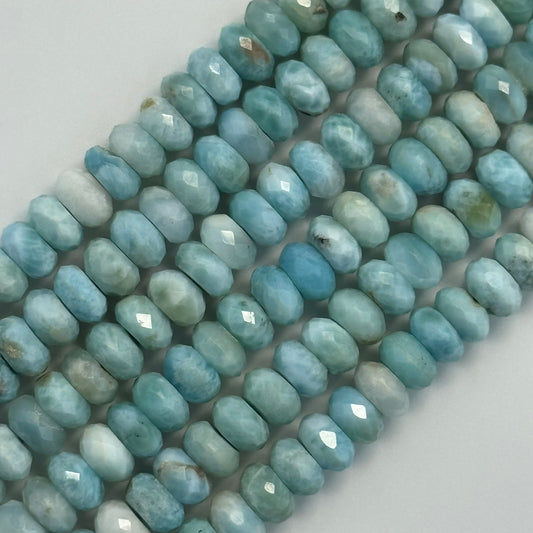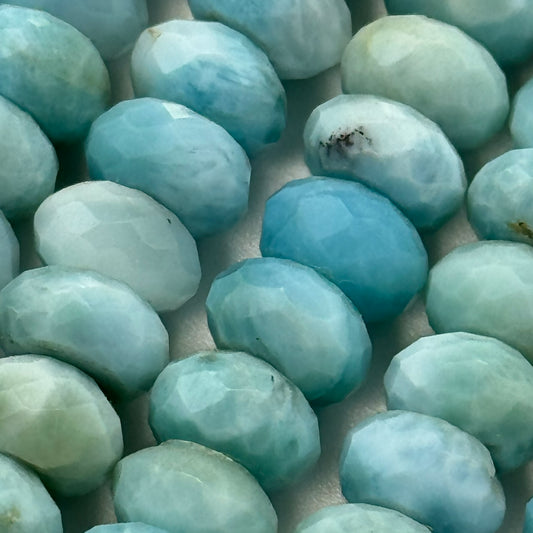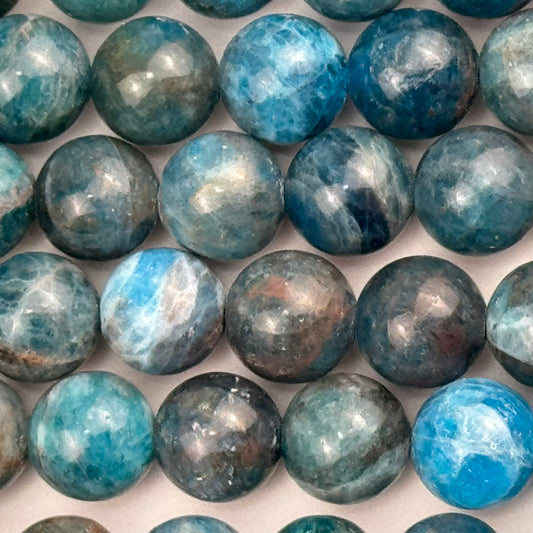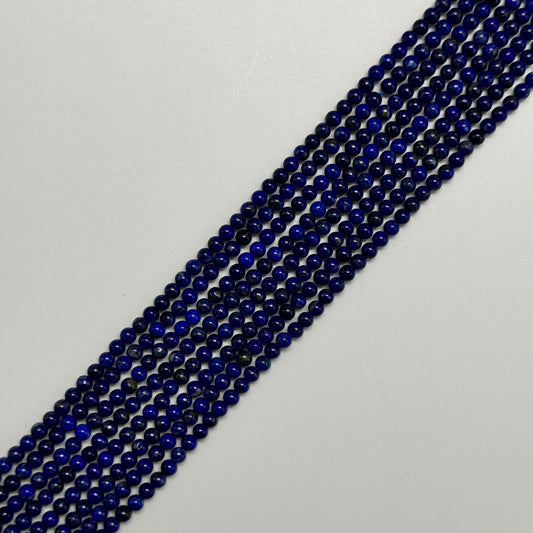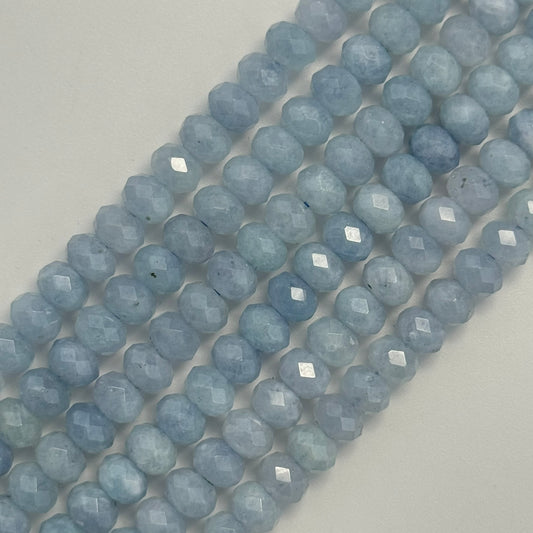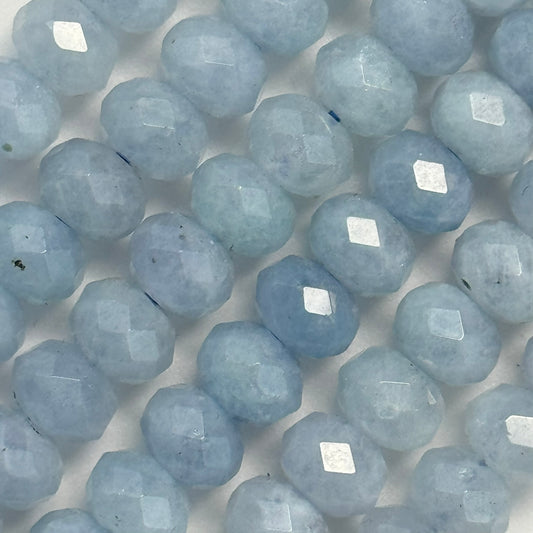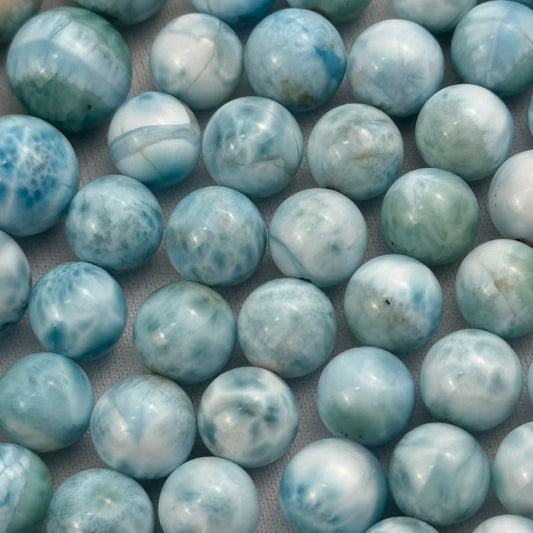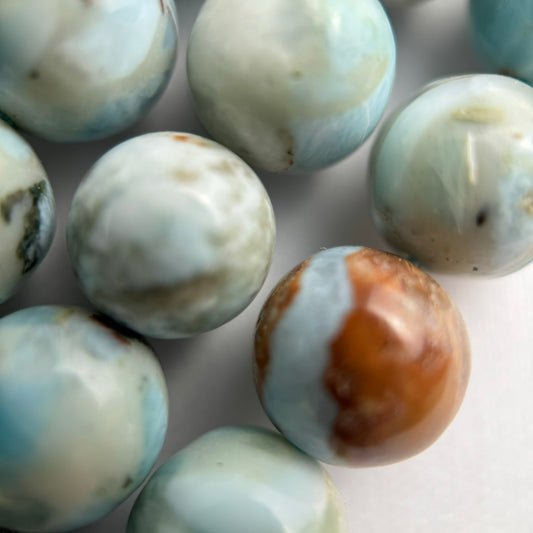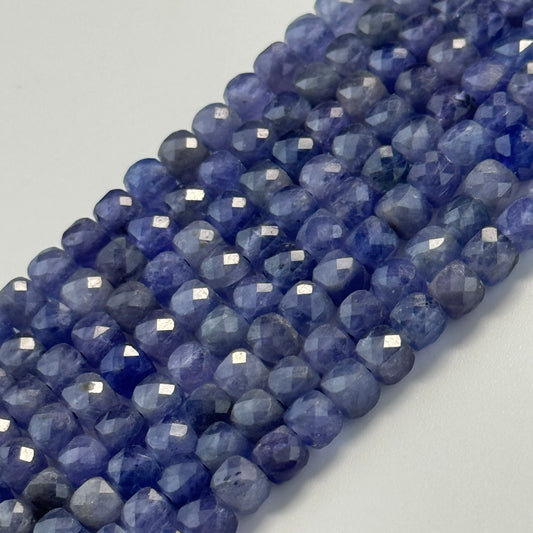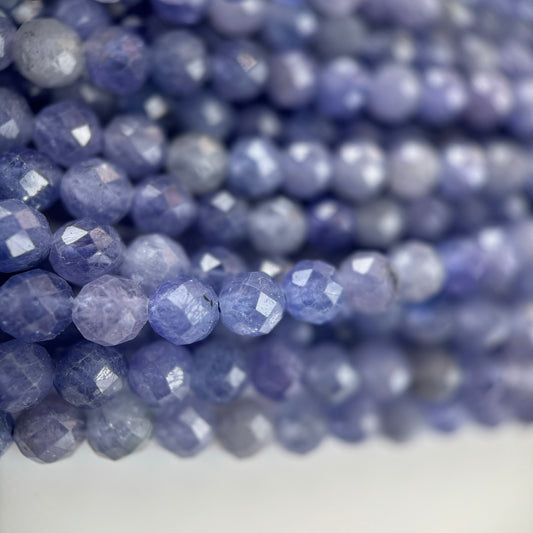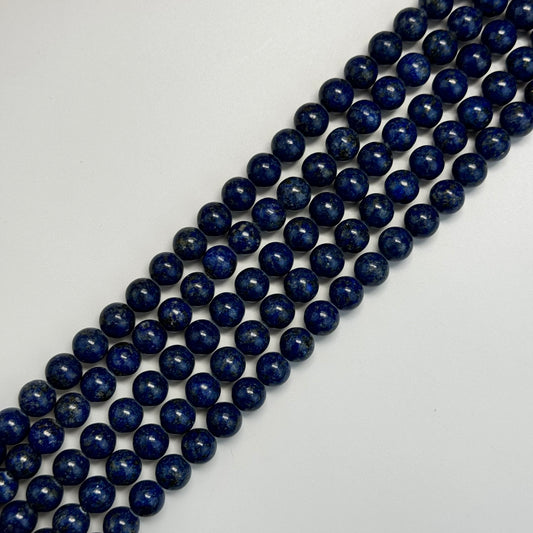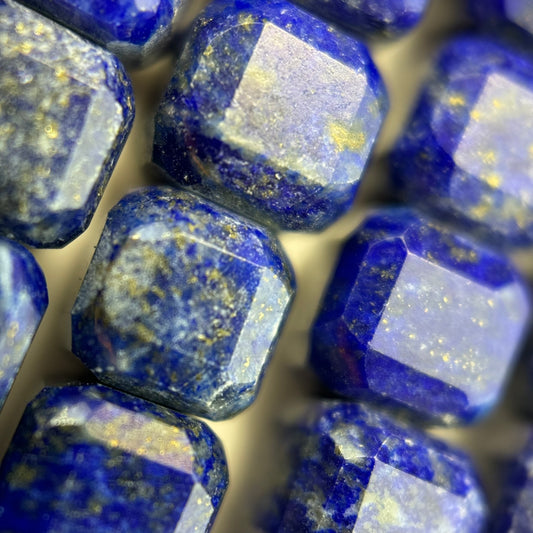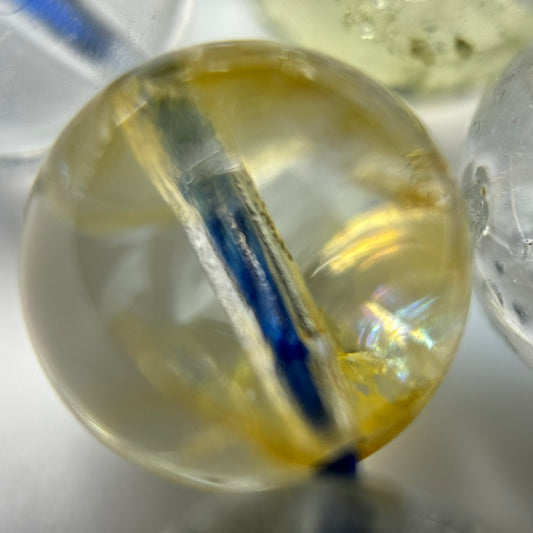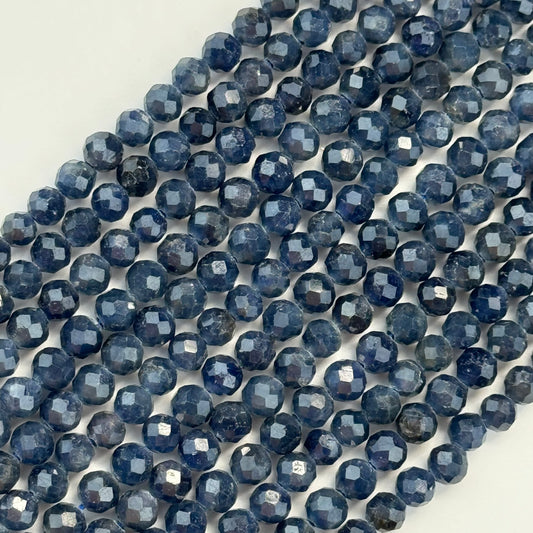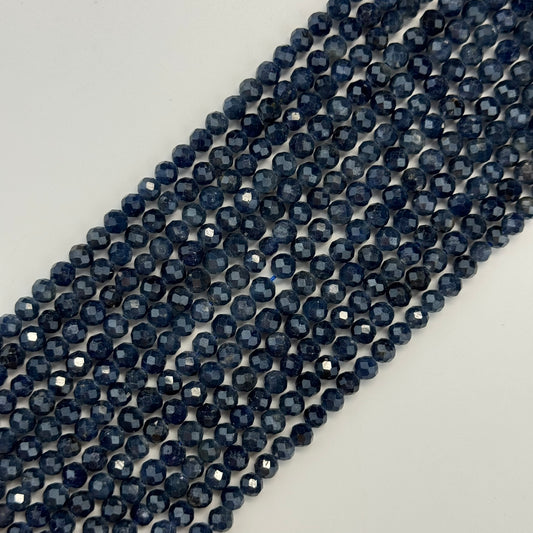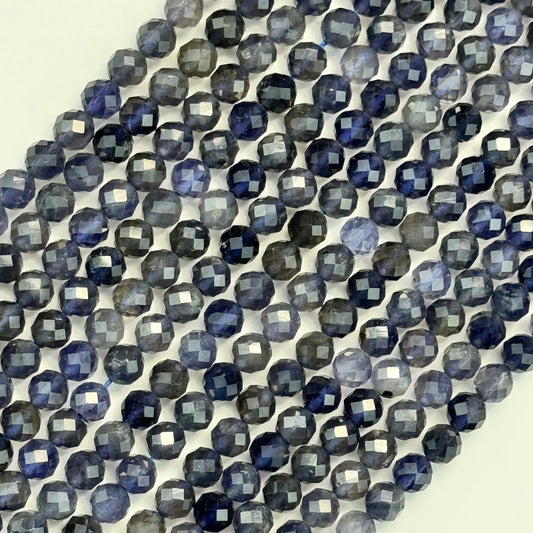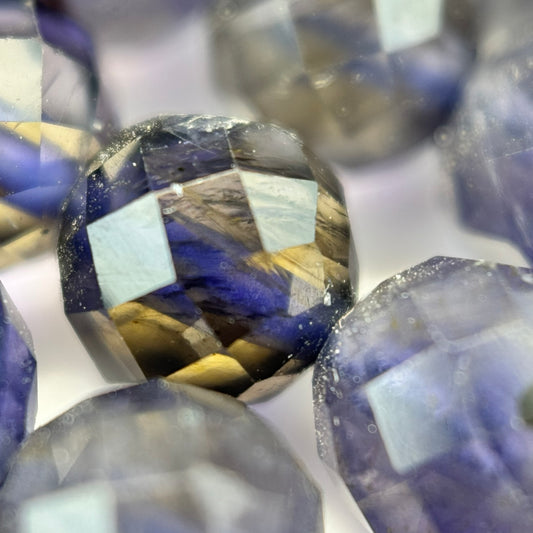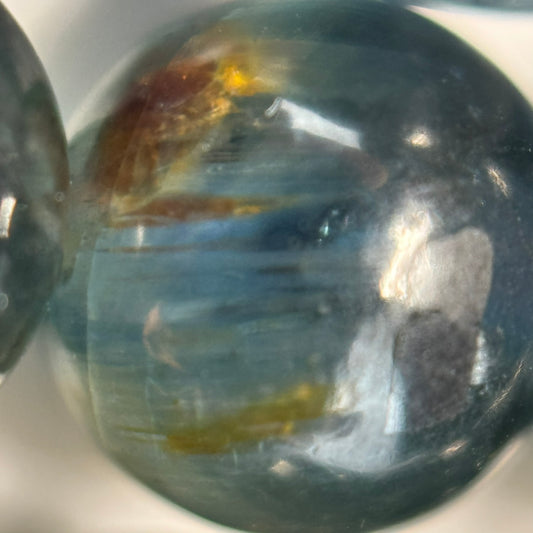Blue Gemstones: Light and Dark Precious & Semi-Precious Gemstone and Crystal Beads
Blue Gemstones, Their Meanings, and Mohs Hardness, and Birthstones
- Sapphire (Mohs 9, September birthstone) – Symbolizes wisdom, royalty, and divine favor.
- Blue Topaz (Mohs 8, December birthstone) – Represents clarity, communication, and truth.
- Aquamarine (Mohs 7.5–8, March birthstone) – Brings calm, courage, and protection for travelers.
- Turquoise (Mohs 5–6, December birthstone) – Provides protection, strength, and healing energy.
- Lapis Lazuli (Mohs 5–5.5, alternative September birthstone) – Encourages self-expression, wisdom, and inner truth.
- Tanzanite (Mohs 6–7, December birthstone) – Enhances intuition, transformation, and spiritual growth.
- Blue Zircon (Mohs 6.5–7.5, December birthstone) – Promotes prosperity, honour, and self-confidence.
- Kyanite (Mohs 4.5–7) – Aligns chakras, aids meditation, and clears energy blockages.
- Iolite (Mohs 7–7.5) – Supports inner vision, creativity, and journeying within.
- Larimar (Mohs 4.5–5) – Calms emotions, heals communication issues, and soothes stress.
- Blue Chalcedony (Mohs 6–7) – Absorbs negative energy and promotes harmony.
- Azurite (Mohs 3.5–4) – Enhances intuition, insight, and clears mental confusion.
- Blue Fluorite (Mohs 4) – Brings mental clarity, focus, and spiritual awakening.
- Blue Opal (Mohs 5.5–6.5, October birthstone) – Encourages creativity, communication, and emotional healing.
- Blue Goldstone (Mohs 5.5–6) – Man-made glass; symbolizes ambition and positive energy.
- Blue Lace Agate (Mohs 6.5–7) – Provides calmness, soothing stress and anxiety.
- Blue John (Mohs 4) – Rare UK fluorite; brings focus, organization, and clarity.
- Blue Spinel (Mohs 7.5–8, August birthstone - modern/alternative) – Brings rejuvenation, inspiration, and revitalization.
Blue Gemstones and Crystals
Blue gemstones and crystals are highly valued for their calming, protective, and communicative energies. Stones like sapphire, lapis lazuli, aquamarine, and blue topaz are popular choices in jewelry and healing practices. These blue stones often symbolize wisdom, truth, and spiritual growth, making them essential additions to crystal collections or meaningful gemstone jewelry designs.
Light Blue Gemstone
Light blue gemstones include aquamarine, larimar, and blue lace agate. These stones carry soothing and peaceful energies that help reduce stress and enhance clear communication. Light blue gemstones are perfect for delicate jewelry pieces, especially for those seeking serenity and emotional balance in their lives.
Dark Blue Gemstone
Dark blue gemstones such as sapphire, lapis lazuli, iolite, and dark blue spinel are associated with wisdom, confidence, and inner strength. Their deep hues convey elegance and power, making them popular choices for rings and statement jewelry. Spiritually, dark blue stones are believed to open the mind and enhance intuitive abilities.
Pale Blue Semi Precious Gemstone
Pale blue semi-precious gemstones include pale varieties of blue topaz, aquamarine, larimar, and blue chalcedony. These stones are known for their gentle, calming energies, helping with emotional healing and relaxation. Their subtle blue tones make them ideal for understated jewelry that radiates tranquility and grace.
Blue Goldstone Gemstone
Blue goldstone is a man-made glass gemstone infused with copper particles, giving it a sparkling night-sky appearance. Though synthetic, it is widely used in crystal healing for ambition, vitality, and positive energy. Blue goldstone is also popular in beads and cabochons for unique jewelry designs with a shimmering blue effect.
Blue and Green Gemstones
Blue and green gemstones combine the soothing qualities of blue with the growth and healing energies of green. Stones like turquoise (blue-green), chrysocolla, amazonite, and certain fluorites exhibit these hues. They promote emotional balance, open the heart and throat chakras, and are perfect for jewelry that embodies both harmony and vitality.
Blue Gemstones: Scientific Overview
- Sapphire (Corundum) – Composed of aluminium oxide with trace amounts of titanium and iron causing its rich blue color. It is highly durable and used extensively in fine jewelry and watch crystals. Major sources include Sri Lanka, Myanmar, and Madagascar.
- Blue Topaz – A silicate mineral containing aluminium and fluorine. Blue shades are often achieved through irradiation treatment. Commonly sourced from Brazil, Nigeria, and Russia.
- Aquamarine (Beryl) – Beryllium aluminium silicate mineral colored by iron impurities. It is transparent with a vitreous luster and valued for its clear sea-blue appearance. Main sources include Brazil, Pakistan, and Nigeria.
- Turquoise – A hydrated copper aluminium phosphate mineral giving it a distinct blue to greenish-blue color. It is opaque with a waxy to subvitreous luster and has been used in jewelry for thousands of years. Major deposits are in Iran, the USA (Arizona, Nevada), and Egypt.
- Lapis Lazuli – A metamorphic rock primarily composed of lazurite, along with calcite, pyrite, and other minerals. Its intense ultramarine blue comes from lazurite content, and it has been prized since ancient times for carvings and beads. Found mainly in Afghanistan, Chile, and Russia.
- Tanzanite (Zoisite) – A calcium aluminium hydroxyl sorosilicate mineral showing vivid blue to violet hues due to vanadium content. It is only found in Tanzania near Mount Kilimanjaro, making it one of the rarest commercially used gemstones.
- Blue Zircon – A natural silicate mineral containing zirconium. Heat treatment produces its bright blue color. Known for its high refractive index and brilliance, sourced from Cambodia, Myanmar, and Sri Lanka.
- Kyanite – An aluminium silicate mineral typically forming bladed crystals. Displays a unique blue hue with strong pleochroism. Main sources include Nepal, Brazil, and Switzerland.
- Iolite (Cordierite) – A magnesium iron aluminium cyclosilicate mineral with strong pleochroism, appearing blue to violet depending on viewing angle. Used as a cheaper alternative to sapphire. Found in India, Sri Lanka, and Mozambique.
- Larimar (Pectolite) – A rare blue variety of pectolite colored by copper. Exhibits a distinctive light sky-blue to greenish-blue pattern. Only found in the Dominican Republic.
- Blue Chalcedony – A microcrystalline quartz variety with a translucent, milky to light blue color. Known for its waxy luster and calming appearance. Found in Namibia, Turkey, and the USA.
- Azurite – A copper carbonate mineral with a deep azure-blue color. Often forms with malachite in the same deposits. Used mainly as a collector stone and pigment historically. Major sources include Morocco, Mexico, and the USA.
- Blue Fluorite – Composed of calcium fluoride, fluorite can occur in a range of colors including blue. Its transparency and vivid color make it popular among collectors. Found in China, Mexico, and South Africa.
- Blue Opal – A hydrated amorphous silica mineral. Blue opals are often translucent to opaque with a soft blue hue, mainly sourced from Peru and Oregon, USA.
- Blue Goldstone – A man-made glass infused with copper particles giving it a sparkly deep blue appearance. Though synthetic, it is widely used in beads and cabochons for jewelry making.
- Blue Lace Agate – A banded chalcedony variety with light blue and white lace-like patterns. Valued for its calming aesthetic and used extensively in beadwork and cabochons.
- Blue John – A rare variety of fluorite with blue-purple banding, historically mined in Derbyshire, UK. Used for ornamental carvings and decorative pieces.
- Blue Spinel – A natural magnesium aluminium oxide mineral with cobalt causing its blue color. Highly valued as a durable and brilliant alternative to sapphire. Found mainly in Sri Lanka, Myanmar, and Vietnam.
Blue Gemstone Beads in Jewelry Making
Blue gemstone beads have been cherished throughout history for their calming and elegant hues. From deep royal sapphire to light aquamarine, these beads add a sense of sophistication and tranquility to any jewelry design. Their versatile shades make them suitable for both bold statement pieces and delicate everyday accessories.
Many jewelry makers use blue gemstone beads to create necklaces, bracelets, and earrings that convey peace, wisdom, and communication. Stones like lapis lazuli and turquoise are popular choices for beaded jewelry due to their striking opaque colors, while faceted blue topaz or aquamarine beads add brilliance and sparkle to luxury designs.
Using blue gemstone beads in jewelry making also allows designers to incorporate deeper meanings into their creations. For example, aquamarine beads symbolize courage and calmness, while kyanite beads are believed to align energy pathways. These properties make blue gemstone jewelry not just beautiful but meaningful to the wearer.
Artisans often combine blue gemstone beads with sterling silver, gold, or contrasting gemstones to highlight their colors. Pairing blue beads with white pearls, for example, creates a timeless ocean-inspired piece, whereas combining them with black onyx adds depth and sophistication to modern designs.
Whether crafting beaded malas, wire-wrapped earrings, or elegant bracelets, blue gemstone beads remain a staple in jewelry making. Their beauty, symbolism, and versatility ensure they continue to inspire designers and captivate customers seeking unique and meaningful gemstone jewelry.
Frequently Asked Questions
What are the names of blue gemstones?
Some of the most well-known blue gemstones are sapphire, blue topaz, aquamarine, turquoise, lapis lazuli, tanzanite, blue zircon, kyanite, iolite, larimar, blue chalcedony, azurite, blue fluorite, blue opal, blue goldstone, blue lace agate, blue john, and blue spinel.
What makes blue gemstones blue?
Blue gemstones get their color from trace elements or impurities in their crystal structure, such as iron, titanium, or copper, which absorb certain wavelengths of light and reflect blue hues.
Which blue gemstones are considered birthstones?
Blue gemstones that are birthstones include sapphire (September), blue topaz (December), aquamarine (March), turquoise (December), tanzanite (December), blue zircon (December), blue opal (October), and blue spinel (August, modern/alternative).
What is the Mohs hardness of blue gemstones?
The Mohs hardness of blue gemstones varies: sapphire (9), blue topaz (8), aquamarine (7.5–8), turquoise (5–6), lapis lazuli (5–5.5), tanzanite (6–7), blue zircon (6.5–7.5), and others range from 3.5 to 8.
Are all blue gemstones natural?
Most blue gemstones are natural, but some, like blue goldstone, are man-made. Additionally, some natural blue gemstones may be treated to enhance their color.
What are the metaphysical properties of blue gemstones?
Blue gemstones are often associated with calmness, wisdom, communication, spiritual growth, and emotional balance. Each stone may have unique metaphysical meanings.
How should I care for blue gemstones?
Care for blue gemstones depends on their hardness and composition. Hard stones like sapphire can be cleaned with mild soap and water, while softer stones like turquoise should be kept away from chemicals and moisture.
Can blue gemstones be used in all types of jewelry?
Yes, blue gemstones are versatile and can be used in rings, necklaces, bracelets, earrings, and more. The choice of stone should consider its hardness and durability for the intended jewelry type.
What is the rarest blue gemstone?
Tanzanite is considered one of the rarest blue gemstones, as it is found only in a small area near Mount Kilimanjaro in Tanzania.
Are blue gemstones expensive?
The price of blue gemstones varies widely. Sapphires and tanzanite can be very expensive, while stones like blue topaz and blue chalcedony are more affordable.
What are synthetic blue gemstones?
Synthetic blue gemstones are lab-created stones that mimic the appearance and properties of natural blue gemstones, such as synthetic sapphire or blue spinel.
Can blue gemstones fade over time?
Some blue gemstones, like turquoise and dyed stones, can fade if exposed to sunlight or chemicals. Others, like sapphire, retain their color very well.
What are the best blue gemstones for engagement rings?
Sapphire is the most popular blue gemstone for engagement rings due to its beauty and durability. Blue diamond, aquamarine, and blue spinel are also good choices.
Are there blue gemstones suitable for men's jewelry?
Yes, blue gemstones like lapis lazuli, turquoise, sapphire, and blue topaz are popular in men's rings, bracelets, and cufflinks.
What are the healing properties of blue gemstones?
Blue gemstones are believed to promote relaxation, reduce stress, enhance communication, and support spiritual growth, according to crystal healing traditions.
Where are blue gemstones found?
Blue gemstones are mined worldwide. Sapphires are found in Sri Lanka, Myanmar, and Madagascar; turquoise in Iran and the USA; tanzanite in Tanzania; and aquamarine in Brazil and Nigeria.
What is the difference between blue gemstones and blue crystals?
"Blue gemstones" usually refers to minerals used in jewelry, while "blue crystals" can include any blue mineral specimen, whether or not it is used as a gem.
Can blue gemstones be used for meditation?
Yes, many people use blue gemstones like lapis lazuli, kyanite, and aquamarine in meditation to promote calmness, clarity, and spiritual insight.
What are some affordable blue gemstones?
Affordable blue gemstones include blue topaz, blue chalcedony, blue lace agate, and blue goldstone.
How do I know if a blue gemstone is real?
To verify if a blue gemstone is real, consult a certified gemologist or request a gemstone certificate. Look for natural inclusions, consistent color, and proper hardness for the stone type.


